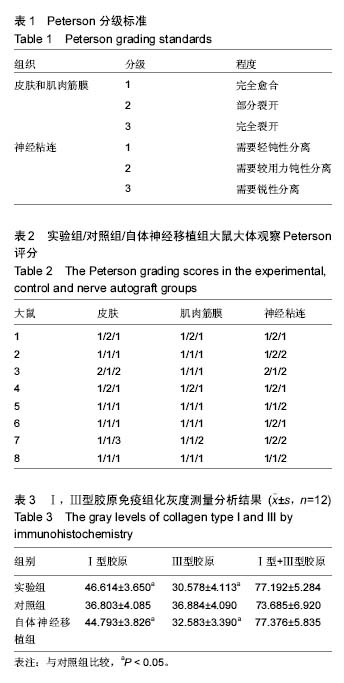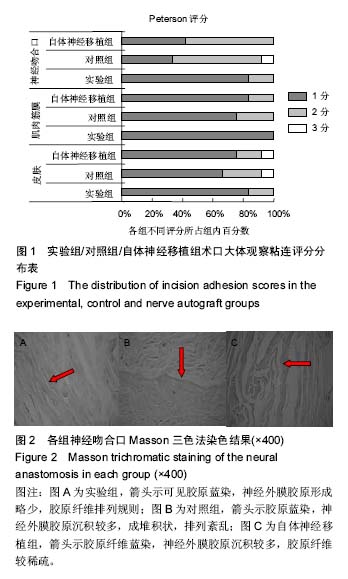| [1] Hudson TW,Zawko S,Deister C,et al. Optimized acellular nerve graft is Immunologically tolerated and supports regeneration. Tissue Eng. 2004;10(11):1641-1651.
[2] Sun MX,Tang JS,Xu WJ.Experimental study on chemical extracted acellular nerve allograft.Chin J Orthop. 2006;26(4):267-271.
[3] Hudson TW,Liu SY,Schmidt CE.Engineering an improved acellular nerve graft via optimized chemical processing.Tissue Eng. 2004;10(9-10):1346-1358.
[4] 黄永旺,范学政.几丁糖与聚乳酸合成生物材料修复周围神经缺损[J].中国组织工程研究,2015,19(25):4059-4063.
[5] 刘奔,张彩顺,高绪斌,等.聚己内酯/壳聚糖神经导管复合骨髓间充质干细胞促进大鼠坐骨神经损伤修复的研究[J].中国生物工程杂志,2014,34(2):34-38.
[6] 张孙富,王斌.合成可生物降解神经导管修复损伤周围神经:生物相容性良好[J].中国组织工程研究, 2015,19(25): 4054-4058.
[7] 王华松,吴刚,黄继锋,等.新型仿生人工神经导管修复周围神经缺损的初步临床观察[J].中国临床解剖学杂志, 2014, 32(6):735-738.
[8] 李玢,郝立君.不同神经导管材料的研究进展[J].中国美容整形外科杂志,2014,25(1):62-64.
[9] Arslantunali D, Budak G, Hasirci V. Multiwalled CNT-pHEMA composite conduit for peripheral nerve repair. J Biomed Mater Res A. 2014;102(3):828-841.
[10] Özgenel GY.Effects of hyaluronic acid on peripheral nerve.scarring and regeneration in rats. Microsurgery. 2003;23:575-581.
[11] 崔媛,段潜,李艳辉.透明质酸的研究进展[J].长春理工大学学报(自然科学版),2011,34(3):101-106.
[12] 朱维波,王端诚,颜廷亭,等.透明质酸钠/魔芋葡甘聚糖复合多孔膜的制备及性能研究[J].材料导报, 2014,28(4): 38-41.
[13] 陈建澍,王婧茜,易喻,等.透明质酸及其衍生物研究进展[J].中国生物工程杂志,2015,35(2): 111-118
[14] 阮超越,马维虎,李国庆.透明质酸及其衍生物在骨组织应用中的研究进展[J]. 北京生物医学工程, 2015,34(2): 203-207.
[15] 蒋延超,蒋世云,傅凤鸣,等.透明质酸生物合成途径及基因工程研究进展[J].中国生物工程杂志, 2015,35(1):104-110.
[16] Sun MX,Lu SB,Tang JS.Experimental study on repairing different length nerve defects with chemical extracted acellular nerve allograft. Chin J Orthop. 2006;14(8):603-607.
[17] 王冠军,孙明学,卢世璧,等.改良化学去细胞同种异体神经制备方法的实验研究[J].中国矫形外科杂志, 2007, 15(12): 929-932.
[18] 管树军,王伟,李岩.冻融联合优化化学法制备粗大去细胞同种异体神经[J].中国组织工程研究, 2015,19(12): 1914-1918.
[19] Zhang Y,Zhang H,Katiella K,et al.Chemically extracted acellular allogeneic nerve graft combined with ciliary neurotrophic factor promotes sciatic nerve repair. Neural Regen Res. 2014;9(14):1358-1364.
[20] 王在军,韩壮,徐先立,等.去细胞神经与自体神经移植桥接修复大鼠坐骨神经缺损的对比研究[J].解剖科学进展, 2013,19(2):163-166.
[21] Petersen J,Russell L,Andrus K,et al.Reduction of extraneural scarring by Adcon-T/N after surgical intervention. Neurosurgery. 1996;38:976-984.
[22] 林强,蔡杨庭,李皓莘.负载浓度梯度NFG的周围神经导管修复大鼠周围神经缺损的实验研究[J].中国修复重建外科杂志,2014,28(2):167-172.
[23] 刘彦冬,窦源东,侯春林,等.电纺丝壳聚糖/聚乳酸神经导管修复大鼠周围神经缺损的实验研究[J].中国修复重建外科杂志,2015,29(5):600-608.
[24] 池昊天,阳运康.干细胞与脱细胞异体神经支架在周围神经长段缺损中的应用[J].中国组织工程研究, 2014, 18(21):3398-3405.
[25] 王宇博,丁新玲,张春光.胶原神经再生室复合修复周围神经损伤的作用[J].赤峰学院学报(自然科学版), 2014, 30(3):38-39.
[26] 冷承浩,郝铁成,丁冬,等.NGF和GM1联合应用对去细胞异种神经支架修复大鼠坐骨神经陈旧性缺损的影响[J].神经解剖学杂志,2014,30(1):86-92.
[27] 吴斗,刘强,龚强,等.透明质酸抑制周围神经局部瘢痕形成的作用[J].中国临床康复, 2006,10(9):77-80.
[28] Mohammad J, Warnke P, Pan Y, et al. Increased axonal regeneration through a biodegradable amnionic tube nerve conduit: effect of local delivery and incorporation of nerve growth factor/hyaluronic acid media. Ann Plast Surg. 2000;44(1):59-64.
[29] 吴婷,李朝晖,崔占峰,等.应用多种水凝胶支架材料构建三维神经干细胞培养模型[J]. 中国细胞生物学学报, 2015, 37(1):66-73.
[30] Wei W,Li Z,Ming F,et al. Compatibility of hyaluronic acid hydrogel and skeletal muscle myoblasts. Biomed Mat. 2009;4(2):7.
[31] 赖晓文,何晓升,钟晓春,等.不同时期增生性瘢痕组织内透明质酸含量与含水量的相关性[J].中国组织工程研究与临床康复,2008,12(2):323-325.
[32] 刘海峰,常津,陈亦平,等.不同透明质酸的浓度对明胶--透明质酸薄膜性能的影响[J].中国生物医学工程学报, 2008, 27(4):603-610.
[33] 黄小忠,管国强.透明质酸生理功能及其应用研究进展[J].畜牧与饲料科学,2015,36(1): 21-25.
[34] 丁金聚,孙伟庆.透明质酸复合材料研究现状[J].中国组织工程研究, 2015,19(21):3403- 3408.
[35] Lebourg M,Martinez-Diaz S,Garcia-Giralt N,et al. Cell-free cartilage engineering approach using hyaluronic acid-polycaprolactone scaffolds: a study in vivo. J Biomater Appl.2014;28(9):1304-1315.
[36] 杨泽龙,陈竹,刘康,等.Ⅱ型胶原-透明质酸构建组织工程软骨复合三维纳米支架的体外实验研究[J].中国修复重建外科杂志,2013,27(10):1240-1245.
[37] 赵丽,梁晓龙,张玉杰,等.表皮生长因子--透明质酸复合膜对大鼠皮肤切口愈合的影响[J].解放军医药杂志, 2015, 27(7):40-43.
[38] Wu Z,Tang Y,Fang H,et al.Decellularized scaffolds containing hyaluronic acid and EGF for promoting the recovery of skin wounds. J Mater Sci Mater Med. 2015; 26(1):5322.
[39] 马林枭,鲍济洪,陈斌.瘢痕:评估、防治、早期干预方法的研究与进展[J].中国组织工程研究, 2015,19(20): 3253-3257.
[40] 谭新东,李希军,叶雪玲.透明质酸对创面胶原代谢的影响[J].中国美容医学,2012,21(8):1332-1333. |
.jpg) 文题释义:
瘢痕:神经再生室内复杂的微环境条件会对神经纤维的延伸与重建产生影响,新生的神经轴突再生速度缓慢且没有穿透能力,一旦遇到炎性肉芽组织或瘢痕组织等障碍后,或者造成神经纤维生长扭曲,或者发生创伤性神经瘤的失败后果。如何防止周围神经损伤局部炎症区的炎性渗出物及纤维结缔组织不长入神经断端,是防止神经纤维瘤形成的关键。
去细胞异体神经:在众多的桥接修复神经缺损的替代载体中,异体神经一直是人们想利用的自体神经移植替代载体,但免疫排斥反应是导致新鲜异体神经移植失败的主要原因。为了最大限度地去除异体神经免疫原性物质,同时较完好地保存神经内部结构和细胞外基质的活性成分,将同种异体神经进行去细胞去抗原处理。在清除神经免疫原性物质的同时,能够制备出三维网管状神经结构保存较好的去细胞异体神经。
文题释义:
瘢痕:神经再生室内复杂的微环境条件会对神经纤维的延伸与重建产生影响,新生的神经轴突再生速度缓慢且没有穿透能力,一旦遇到炎性肉芽组织或瘢痕组织等障碍后,或者造成神经纤维生长扭曲,或者发生创伤性神经瘤的失败后果。如何防止周围神经损伤局部炎症区的炎性渗出物及纤维结缔组织不长入神经断端,是防止神经纤维瘤形成的关键。
去细胞异体神经:在众多的桥接修复神经缺损的替代载体中,异体神经一直是人们想利用的自体神经移植替代载体,但免疫排斥反应是导致新鲜异体神经移植失败的主要原因。为了最大限度地去除异体神经免疫原性物质,同时较完好地保存神经内部结构和细胞外基质的活性成分,将同种异体神经进行去细胞去抗原处理。在清除神经免疫原性物质的同时,能够制备出三维网管状神经结构保存较好的去细胞异体神经。.jpg) 文题释义:
瘢痕:神经再生室内复杂的微环境条件会对神经纤维的延伸与重建产生影响,新生的神经轴突再生速度缓慢且没有穿透能力,一旦遇到炎性肉芽组织或瘢痕组织等障碍后,或者造成神经纤维生长扭曲,或者发生创伤性神经瘤的失败后果。如何防止周围神经损伤局部炎症区的炎性渗出物及纤维结缔组织不长入神经断端,是防止神经纤维瘤形成的关键。
去细胞异体神经:在众多的桥接修复神经缺损的替代载体中,异体神经一直是人们想利用的自体神经移植替代载体,但免疫排斥反应是导致新鲜异体神经移植失败的主要原因。为了最大限度地去除异体神经免疫原性物质,同时较完好地保存神经内部结构和细胞外基质的活性成分,将同种异体神经进行去细胞去抗原处理。在清除神经免疫原性物质的同时,能够制备出三维网管状神经结构保存较好的去细胞异体神经。
文题释义:
瘢痕:神经再生室内复杂的微环境条件会对神经纤维的延伸与重建产生影响,新生的神经轴突再生速度缓慢且没有穿透能力,一旦遇到炎性肉芽组织或瘢痕组织等障碍后,或者造成神经纤维生长扭曲,或者发生创伤性神经瘤的失败后果。如何防止周围神经损伤局部炎症区的炎性渗出物及纤维结缔组织不长入神经断端,是防止神经纤维瘤形成的关键。
去细胞异体神经:在众多的桥接修复神经缺损的替代载体中,异体神经一直是人们想利用的自体神经移植替代载体,但免疫排斥反应是导致新鲜异体神经移植失败的主要原因。为了最大限度地去除异体神经免疫原性物质,同时较完好地保存神经内部结构和细胞外基质的活性成分,将同种异体神经进行去细胞去抗原处理。在清除神经免疫原性物质的同时,能够制备出三维网管状神经结构保存较好的去细胞异体神经。

.jpg) 文题释义:
瘢痕:神经再生室内复杂的微环境条件会对神经纤维的延伸与重建产生影响,新生的神经轴突再生速度缓慢且没有穿透能力,一旦遇到炎性肉芽组织或瘢痕组织等障碍后,或者造成神经纤维生长扭曲,或者发生创伤性神经瘤的失败后果。如何防止周围神经损伤局部炎症区的炎性渗出物及纤维结缔组织不长入神经断端,是防止神经纤维瘤形成的关键。
去细胞异体神经:在众多的桥接修复神经缺损的替代载体中,异体神经一直是人们想利用的自体神经移植替代载体,但免疫排斥反应是导致新鲜异体神经移植失败的主要原因。为了最大限度地去除异体神经免疫原性物质,同时较完好地保存神经内部结构和细胞外基质的活性成分,将同种异体神经进行去细胞去抗原处理。在清除神经免疫原性物质的同时,能够制备出三维网管状神经结构保存较好的去细胞异体神经。
文题释义:
瘢痕:神经再生室内复杂的微环境条件会对神经纤维的延伸与重建产生影响,新生的神经轴突再生速度缓慢且没有穿透能力,一旦遇到炎性肉芽组织或瘢痕组织等障碍后,或者造成神经纤维生长扭曲,或者发生创伤性神经瘤的失败后果。如何防止周围神经损伤局部炎症区的炎性渗出物及纤维结缔组织不长入神经断端,是防止神经纤维瘤形成的关键。
去细胞异体神经:在众多的桥接修复神经缺损的替代载体中,异体神经一直是人们想利用的自体神经移植替代载体,但免疫排斥反应是导致新鲜异体神经移植失败的主要原因。为了最大限度地去除异体神经免疫原性物质,同时较完好地保存神经内部结构和细胞外基质的活性成分,将同种异体神经进行去细胞去抗原处理。在清除神经免疫原性物质的同时,能够制备出三维网管状神经结构保存较好的去细胞异体神经。